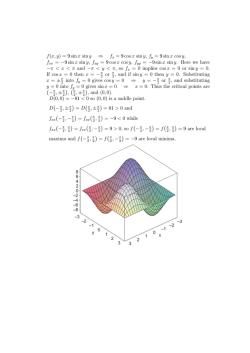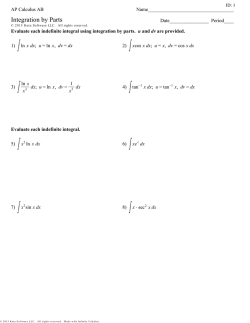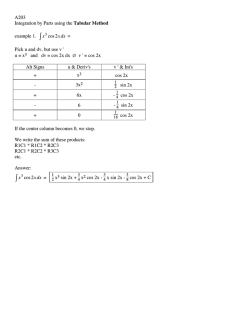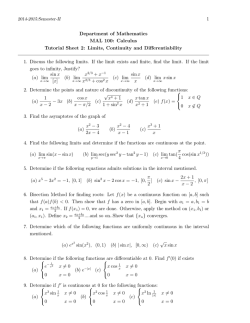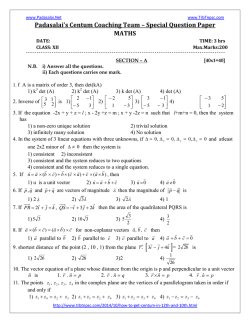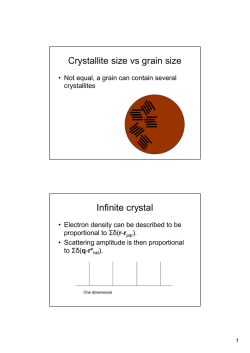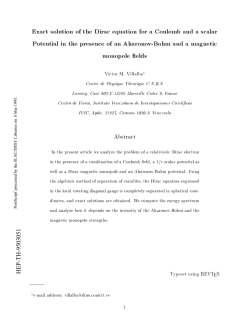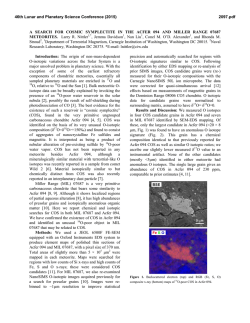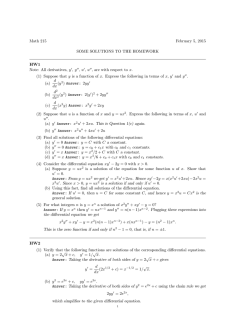
34718 - Radboud Repository
PDF hosted at the Radboud Repository of the Radboud University
Nijmegen
The version of the following full text has not yet been defined or was untraceable and may
differ from the publisher's version.
For additional information about this publication click this link.
http://hdl.handle.net/2066/34718
Please be advised that this information was generated on 2015-02-06 and may be subject to
change.
G eneralized k in etic eq u ation s for charge carriers in graphene
M. A uslender1 and M. I. K atsnelson2
University of the Negev,
P O B 653, Beer Sheva 84105, Israel
2Institute f o r Molecules and Materials, Radboud University of Nijmegen,
NL-6525 E D Nijmegen, The Netherlands
(Dated: February 1, 2008)
A bstract
A system of generalized kinetic equations for the distribution functions of two-dimensional Dirac
fermions scattered by impurities is derived in the Born approximation with respect to short-range
impurity potential. It is proven that the conductivity following from classical Boltzmann equation
picture, where electrons or holes have scattering amplitude reduced due chirality, is justified except
for an exponentially narrow range of chemical potential near the conical point. When in this range,
creation of infinite number of electron-hole pairs related to quasi-relativistic nature of electrons in
graphene results in a renormalization of minimal conductivity as compared to the Boltzmann term
and logarithmic corrections in the conductivity similar to the Kondo effect.
arXiv:0707.2804v2
[cond-mat.mes-hall] 19 Oct 2007
1 Ben-Gur ion
1
In tro d u c tio n
Recent discovery of two-dimensional (2D) allotrope of carbon, graphene, and experim en
ta l dem onstration of its massless Dirac energy spectrum has initiated a huge experim ental
and theoretical activity in the field (for review, see Refs.1,2,3). One of the most interest
ing aspects of the graphene physics from theoretical point of view is a deep and fruitful
relation w ith the quantum electrodynam ics.4’5,6’7’8’9’10 In particular, anomalous tran sp o rt
properties of 2D Dirac fermions, such as finite conductivity of order of e2/ h in the limit
of zero charge carrier concentration 11,12,13,14,15,16 can be associated w ith a specific quantum
relativistic phenomenon known as Zitterbew egung.7 The current operator of non-relativistic
electron commutes w ith its kinetic-energy H am iltonian and does not commute w ith the
potential-energy one. Yet, it is vice versa for the Dirac electrons th a t is a reason for the
Zitterbewegung. The same com m utation properties hold for graphene in the case where the
potential does not cause Umklapp process. Qualitatively, an im purity potential acting on
non-relativistic electron creates random friction-like force which causes finite conductivity.
This is expressed quantitatively in the standard theory of electronic tran sp o rt in disor
dered m etals and semiconductors17,18,19,20 by deriving and solving the classical Boltzm ann
equation. The im purity potential action on the Dirac electron can not be described w ithin
such a simple picture. Despite this im portant difference many authors exploited the classi
cal Boltzm ann equation to analyze electron tran sp o rt in graphene.10,16,21,22,23,24 Rigorously
speaking, it is not clear w hat will be the limits of its applicability in this unusual situa
tion. Our work presents a consequent derivation of kinetic equations for the 2D massless
Dirac fermions. Some of our results for the static conductivity are similar to those obtained
by various quantum-field theory m ethods.11,12,13,14,15,16 The approach based on the kinetic
equation provides an alternative view on the anomalous tran sp o rt properties of graphene. It
can be easier generalized for more complicated situations such as strong electric fields, hot
electrons, etc. These issues are beyond the scope of the present work. We will not consider
also the effects of Anderson localization and antilocalization25,26,27,28 in graphene restricting
ourselves by the case of a weak disorder in the leading-order approxim ation. As we will
see even in this case the problem turns out to be very nontrivial and instructive. We will
prove th a t for not too small doping the standard Boltzm ann equation w ith the scattering
am plitude specific for massless fermions does give the leading term in the conductivity and
2
will find corrections to it due to the Zitterbewegung. In particular, these corrections have
an interesting tem perature dependence similar to the Kondo effect.
A general idea of the approach used here is traced back to seminal papers by Kohn and
L uttinger.29 Starting from Schrodinger equation for noninteracting electrons in a random
im purity potential they consequently derived the kinetic equation for diagonal (in momen
tu m representation) m atrix elements of the one-electron density m atrix in the cases of weak
potential or small im purity concentration. In these cases the kinetic equation turned out to
be identical w ith the classical Boltzm ann equation. Even for the simplest system to which
it was initially applied, the Kohn and L uttinger treatm ent 29 proved not simple. For m ulti
component systems one may also follow the route of Ref.29 and infer on existence of a closed
system for distribution functions in the m om entum space - usual ones and functions th a t
describe inter-subsystem s transitions - bu t complexity of deriving such kinetic equations
sharply increases.
Several established formalisms exist nowadays, which autom ate the above derivation as
suming existence of some kinetic equations in principle. A partial list includes KadanoffBaym 30, Keldysh 31,32, Zubarev nonequilibrium statistical operator (NSO)33 (for the NSO
m ethod, see also recent reviews34,35) and Peletminskii-Yatsenko36 methods. The Keldysh,
NSO and Peletminskii-Yatsenko m ethods have close rationales.
Namely, existence of an
asym ptotic density m atrix which allows for W ick-rule decoupling of the creation and an
nihilation operators product averages is assumed in these methods. The consideration of
non-equilibrium at strong interactions benefits using the Keldysh m ethod which is distin
guished for highly developed diagram technique. At weak interactions, however, when the
Born approxim ation is applicable the simplest approach in our opinion is w ith the NSO
and Peletminskii-Yatsenko methods.
This is because in the Born approxim ation, closed
equations for the averages of gross variables, generalized kinetic equations (GKE), which
describe non-equilibrium of interest (provided th a t such variables are declared in advance)
were derived w ithin these frameworks in late 60’s once for all.33,34,35,36
In this paper we obtain and asym ptotically solve G K E for spatially homogeneous
graphene in order to calculate the linear-response conductivity. The m ain difference w ith
the canonical case29 is th a t for graphene the diagonal in the m om entum representation av
erage density m atrix is still two by two m atrix in the pseudospin space, its off-diagonal
elements describing the Zitterbewegung. This makes the GKE structure, on the whole, es
3
sentially different from th a t of the classical kinetic equation. The structure of the paper
is the following. In section I we present original expressions for the H am iltonian, current
and coordinate operators. In section II we specify the gross variables appropriate for the
kinetics in spatially homogeneous case, which in fact are all the density m atrix elements,
and on their base concretize G KE regarding the interaction w ith arbitrary static impurities
as a perturbation. In section III, assuming presence of a therm ostat, we consider linear
response regime (the case of small electric field) and express the linear static conductivity
via two unknown functions of the one-electron energy. These functions, together w ith a
subsidiary function of energy, satisfy a coupled system of linear integral equations resulting
from linearizing GKE in electric field strength. In section IV, we solve th e linearized system
and calculate the conductivity w ithin an ultraviolet cut off D irac-delta im purity potential
asym ptotically in a controllable small param eter, using m ethods of solving singular integral
equations. In section V we discuss the results obtained.
I.
P R E L IM IN A R IE S
We proceed w ith the H am iltonian of two-dimensional massless Dirac fermions describing
charge carriers in graphene if one neglects the Umklapp processes between valleys K and K '
Ho = v ^
p (r ■p ) ^ p
(1)
p
where p is the m om entum vector, v is the velocity,
*p = 1
| • *p = ( /p . /p 2 )
(2)
are two-component pseudospinor operators, 1,2 labelling the sublattices, and
T = (rX,Ty ) , T X =
i 0 1I
i 0 -i
,Ty =
1 o)
yi
i
(3)
o
are the Pauli m atrices in the pseudospin space. We will neglect here real spin and valley
indices. The H am iltonian (1) can be diagonalized using the unitary transform ation m atrix 16
I
Up = — ~ \
4
\
I
where 0 p is the polar angle of the vector p. Hence the new electron operators given by
"
TTt\T>
^
[ ^ pl
6 ^ P^ P 2 ^
[ ^P1
ft-\
and
s p = * p ^ p = ( (p 1 CpO
(6)
are the annihilation and creation operators of the conduction and valence band electrons.
Thus we have
Sp = UpSp, Sp = SpUp
(7)
H 0 = v J 2 sp ( ps( psp,s=±1
(8)
and
In w hat follows we will consider the simplest case where electrons experience action of a
scalar potential V (r) presents. The interaction H am iltonian in this case is given by
Hint = S - 1 £ V (p - p ') S pS p. = S
pp'
Spl>pp.Sp.
(9)
pp'
where S is the graphene layer surface area, V (q) is the Fourier transform of V (r) and
^
1
^pp' =
2o F
(P -
P ')
/ 1 + e- i( ^p- V ) 1 _ e- i( ^p-<V) \
-(6 V
6 )) 1 + g-i(<^p'U V
6 )) I
\ 1 —g-i(^p-
•
^
The current density operator in the new variables reads
j = ev J 2 S pT s p ^ 5 ^ s pjps p ’
p
p
(11)
where
jp
evUpT Up
(jpx,j py) ,
(12)
and
i cos 0 p —i sin 0 p I
i
sin 0 p
i cos 0 p |
jpx = ev \
, jpy = ev I
| .
i sin 0 p —cos <pp I
y —i cos 0 p —sin 0 p
5
(13)
Off-diagonal elements of the current operator correspond to the Zitterbewegung processes.7
For the x and y-components of the current, we further obtain
cos 0Ypp —i6om
sin Yp
0r
V^ I WO
“p
.
p
\ %sin 0 p —cos 0 p
J x = ev
ev
[COS ^p ( t ì ,1^p-1 —
(14)
,-1 ^p>-0 — %Sin ^p (^p-1^p’- 1 —^p— ^p’1)
and
sin 0 p
t
Jy = e v J 2 [ p
evE
%cos 0 p
p
—%cos 0 p —sin 0 p
[sin ^
( 4 .1ip ,1 —4 .-1 ^ ’“ 0 + % cos
(15)
(^p 1 ^ ’_ i —‘• p--1^p-1)
At last, the electron coordinate operator which is necessary to derive the field term in
the kinetic equation reads
R =
^pv^p,
(16)
where V is the gradient operator w ith respect to the m om entum p. Using the above unitary
transform ation, we get
R = ¿ 2 ^ “ pUp V (UpSp) =
£
+ Æ
H pV Sp + i V H i V l
*(Cpi^Cpi + £P,-i^£p,-i)
v
9
V
1
l/2
1
1
\ g*<£p --g*<£p
Up
p
(CpiCpi + CP,-iCp,-i)^ 0 p
(17)
+p ( 4 iîp . - i + 4 , - . î p ^
To simplify R let us perform additional gauge transform ation ^ps —►e~%^ p^ ps th a t re
tains the H am iltonian H 0 unchanged bu t renormalizes the coordinate and current density
operators to take the form
Linter
(18)
p,m=±1
and
(19)
p,m=±1
P
6
respectively. Here we have separated explicitly intraband (electron-electron and hole-hole)
and interband (electron-hole) contributions. Note th a t
d
—eR = J,
dt
(20)
as it should be. The interaction m atrix elements are thus transform ed to
^p• ^pcos —
%s m ------—
2
^p—^p/
%sm —
cos
2
Vpp' ^ V (p — p/)
II.
(21)
T H E B O R N -A P P R O X IM A T IO N K IN E T IC E Q U A T IO N S
A.
G en eral ou tlin e
The basic idea of the m ethods of Refs.33,36 is a concept of so called “coarse-grained”
dynamics. To apply the formalism we are, as noted in Introduction, to suggest the gross
variables P , averages of which ( P ) at the kinetic stage of the evolution are believed to satisfy
GKE. It was proven by Kohn and L uttinger29 th a t, if V (r) is due to random impurities, the
diagonal elements of the one-electron density m atrix in the m om entum representation aver
aged over weakly perturbed non-equilibrium ensemble are self averaging over the im purity
configurations and do obey such a reduced description, at least for weak enough potential
or small im purity concentration. O ur problem is formally different from standard one only
in existence of the interband operators. Therefore we choose the following gross variables
(
Pp
epi£pi
\
cP ,- i Cp , - i
(22)
cPiCp,-i
V £p,-i£pi )
the components of this vector being the second-quantization form of the above m atrix
elements. The corresponding “quasi-equilibrium” or “coarse-grained” statistical operator
(QSO)33,36 is given by
pq = e
- * - E FpPp
-*-E(Fpifpiipi+Fp2ip,-iÎp,-i+Fp3ÇpI5p,-1 +FpVp,_i«pi)
p
= e
p
,
(23)
where
£ ( Fp4 iîpi+FP2îp ,-iîp,-i+Fp3Îpi^p,—i+Fp3^p,-i?pi)
$ = ln Tr e p
7
(24)
is the generalized M asseu-Plank function. As at the equilibrium, Fp are param eters conju
gated to Pp in the sense th a t 33,34,35,36
(P p ) , =
~
§
(25)
t
This QSO is second-quantization representation form of the general density m atrix in the
which allows for Wick rules. Following from it explicit connection between (Pp) and F p,
however, bears no new information.
To obtain GKE one uses the closure condition (Pp)q = (Pp) assumed 33,36 only for the
gross variables, which results in
d
g j ( n , = i( [ « o + WM ,.P]>,
(26)
where the averaging in the right-hand sides is perform ed over NSO obtained from QSO via
an explicit formal prescription 33,36. In our case this averaging is also to incorporate one
over the im purity configurations. Note th a t in all known cases w ith weak interaction the
operators Pp obey closed microscopic dynamics w ith the unperturbed H am iltonian
[ « o . P p ] = £ WpqP,,
q
(27)
where wpq is a known m atrix. It can be shown th a t in our case Eq. (27) sustains even if H 0
includes the interaction w ith an electric field E along the x-axis
H eI = - e E • R = - e E
£
p,m=±1 '
<»)
P
/
At th a t occurrence, the m atrix wpq contains linear in E off-diagonal elements, some of which
involve the gradients of the momentum -conservation delta function.
In the second-order approxim ation w ith respect to H int Eq. (26) can be transform ed33,35,36
to GKE, which have the following form common to all applications
= * £ ^p« w
q
+ ^ p 1’ +
<29>
■
where the generalized collision integrals of the first and second orders are given by33,35,36
J 1’ = i ([Hint, Pp])q
(30)
and
r0
/T
J 2 = lim /
e £tdt
p
£^+0
„
^ i 1’
1\
(31)
q
8
respectively. Here the dependence of the interaction H am iltonian on tim e t is according
to Heisenberg picture w ith H 0 which, in addition to the kinetic energy, may include H ef.
The term in Eq. (31), which involves j P 1 , leads to cancelling possible contributions th a t
diverge in the therm odynam ic limit S ^
to
out of j P 2). This is fair analog (in the Born
approxim ation) to “connected-diagram s” statem ent in the diagram techniques.30,31,32
B.
A verage c u rre n t den sity
Using E q.(15) the average current density can be expressed via the basic averages (Pp)
as follows
^ = ^
= -^ 2
I t(/pi “ fp , - i ) cos 4>p + 2 l m ( g p l ) sin 4>p] d 2p,
(32)
where, by definition,
fp. = { ( ¿ .( p .) , gp. = < & ( * - .> =
(33)
Let us now introduce the electron and hole distribution functions
n p = f p1. Pp = 1 — f p.-1,
(34)
which are, of course, real, and “anom alous” distribution function gp = gp1, which is complex
in general. In the term s of these functions Eq. (32) is w ritten as follows
ev
f
j* = 7 ^ 2
t(n q + -Pq) cos 0q + 2 Im (gq) sin 0 q] d2q
(2n) J
ev
f
[Aq cos (f)q + 2 Im (<jfq) s in 0 q] d 2 q.
(2n)2
C.
(35)
D eriv atio n d etails
Let us now specify Eqs. (29) - (31) for graphene. To this end, consider all the prerequisites
of the calculations required. Using Eq. (21), we find
5 1
ll',m=±1
F (! “ }/) ( cos ^ 2 ^
'
9
1
+ +* sin ^
(36)
'
and so
c
L = /
e£ Hint (t) dt
J —^
cos 01 24*1'
„+ „
e + im (q - t v )
S —1 £
V (l - l')
¡¡',^=±1
0i—
0i/
* sm —
52—
+
e
+
*
m
( Q
+
+
ClmCl',—r
Q
(37)
0
Consider further the com m utators of the gross-variable operators w ith H 0. By a straight
forward calculation we obtain
[Hc 4 s £ p s ]
X]
q,n=±1
+ 7 ^ Sin 0 q£j,rafq-n^ , QsCps
dn
dpx (^Ps^ps)
2o
2p (^ p ^ P ’-5
d - ^ ) s m 0 :p
and
[Hc 4 s £ p , —s]
X
(
- *e^ i n 7 T ^ + V “ sin ^ q fin fq -n ) >4 ^ P - a
n=±1 V
_q,n=±1
dqx
+ieE^~ (4^p-J “
2q
/
eE
I“
2p (4*fp.s “ fi.-sfp.-«) sin p
&
Hence the “precession” term s in the right-hand side of GKE, see Eq. (29), are
q
tI at \\ — -vT?.
v d fps . e E s in (f)p
ps,qs \CpsCqVq
eE -------- 1-------------- Lmgps
dpx
p
\ _ 0.
1
W p s ,q -s \C p s C q s /ç ~
p^gps
^%SVP 9 p s
&
Qp
-e E sin 0p
%
2p
( f ps — ^f P>p,—^s)
W PS
(38)
where we have used the notations introduced in Eq. (33).
To calculate collision integrals for the “norm al” distribution functions f ps and the anom a
lous ones gps we are to perform the com m utation twice - first tim e to commute the gross
variables operators w ith Hint to obtain j P 1 and the second to commute the result of the
(2)
first com m utation w ith L to obtain J p ; . Following this route we get
V (q —q') cos
[ 4 A » , Hint ] = S —^
0q
0q' / c _ c \ t \ a
(Up,q up,q') sqssq's
qq'
• • 0q — 0q'
+. %
s m -----------
^p,q^qsCq/,—s — ^p,q' Cq, —sCq',s
(39)
Averaging this expression over QSO gives J p ^ [fs] = 0. Then, perform ing the second com
m utation using Eqs. (37) and (39), after straightforw ard calculations we obtain the second10
order collision integral for f ps
1
J p2) [fs] = S 2 X
|V (p — q)|2 { s sin (^p — ^ q ) Re (gq)
— n 2 cos2
( Cp + Cq +
1
Cq
Cp
(/ ps - Us) + s sin (0P - 0 q) Im (gq) ^ (tp — Cq)
(40)
Further we have
K w fp.-*>n “ t] = 5 1 X
F (q _ q/) cos
2 ^ q/ ^ pq _ ipq/)
. . .
^q — ^q/
+ %s in ------^pqCqsCq's — ^pq' £q,-s£q',-s^
(41)
Making the second com m utation w ith the use of Eqs. (37) and (41), after straightforw ard
calculations we obtain the second-order collision integral for gps
J V b,] = - S - 2
<p - q> n
x
2 COS2 i s - A
qq'
• gps + gqs
(tp — Cq) + iS
Cq Cp
(gps —gqs)
( f qs + f q,-s) 7TÔ {(Lp — €q) — is~
Cq
- sin (0p - 0 q)
2
6p
- g sin (<^p “ ^q) x
+
tp + t q
Cp + Cq
(42)
This equation describes the Zitterbewegung effects, th a t is, creation of electron-hole pairs
during the charge carrier propagation. Note th a t in b o th Eq. (40) and (42) the configura
tional average of the potential Fourier transform s squared is implied.
P u ttin g together E qs.(38),(40) and (42) we can w rite the final set of GKE for the “norm al”
and “anom alous” distribution functions. It is more convenient, however, to transform these
GKE to a system of equations for the functions
Dp
"y ^ f ps
s=±1
1
np
p p, N p
"y ^ s f ps + 1
s=±1
n p + Pp
(43)
and for gp. Let us rem ind th a t the la tte r and N p define the average current, see Eq. (32).
We have for D p
9I± + e E ? D '
dt
dpx
27r
'S* X
2
2 ^p — 0q
(D p — D q) ^ (tp — Cq) ,
|V (p —q )| cos
11
(44)
which does not involve gp at all, while the equation for N p reads
dN p
^dNp
2eE sin 0 p
r 2- --------------Im
^
df tu + ^ i dpx
p
2n '
^ ',
,, 2 JP_ —1i • ^/ ,
—
Mi
^
S 2 Y 1 \V (p “ q ) |2
1 Sin (^P “ ^
cos2
\ I/"
Re (9 q)
1
+
+ e
1
(ATp - ATq) + sin 0 P - 0q) Im (gq)
Finally, the equation for the complex function gp proves the following
d9p - 2%vpgp + e E ^
+ *— (ATp - 1) sin 0 P
dt
dpx
2p
------- £
|v (p - q )l2 { - i sin ( ^ , - ^q) d c
r [tp
/ ~ t q)\ + —i
1
n £p — CqJ
0
l2 cos
i ^
^
\
2* gp + gq . 2 0p 0q \
+ 7,------— sin (<f>p - <f>q)---------- --— sin ---- ----- \ .
2n £p + £q
n £p + £q
2
J
III.
(46)
T H E L IN E A R R E S P O N S E R E G IM E IN E L E C T R IC FIE L D
In general, Eqs. (44) - (46) are quite complicated. Further we will consider only the regime
of linear response, th a t is, the case of weak electric field. We will restrict ourselves also by
the case of stationary field and neglect its effect on the collision integral. It can be shown
(2)
th a t linear in E corrections to J p ; restore some second order term s of the p ertu rb atio n
expansion of the exact field term considered in the Luttinger-K ohn formalism 29, which lies
out of our scope.
At E = 0, like the classical kinetic equation, Eqs. (44) - (46) have equilibrium solution.
In our case it is three arbitrary function of the energy ep = vp. To develop meaningful
linearization of G KE and the current for small E , we assume, following Ref. 29, presence of
a therm ostat which role is only to establish true equilibrium w ith a tem perature T . Under
this condition the equilibrium distribution functions n 0p and p 0p become, of course, the
electrons and holes Fermi functions, respectively, w ith unique chemical potential ^. Now let
us consider the linearization of G K E derived above in detail.
12
A.
L inearized e q u atio n for Dp
Replacing in the field term of Eq. (44) the distribution functions by their equilibrium value
and linearizing the corresponding collision integral, we obtain the following equation
eE
dDo (ep)
2n
|V (p - q)| 2 cos2
S2 X
0
(8 D P -
6
DJ
8
(ep - t q) ,
(47)
where
Do (e)
1
1
. -, :
e £+ü
t + 1
(48)
Eq. (47) is quite similar to the classical kinetic equation and so is routinely solved exactly.
The solution reads
,
S-Do (eP)
5D p = —eEvT (ep) ---«----- cos^p,
d 6p
t
(49)
(ep) being standard elastic tran sp o rt relaxation tim e given by
1
n
S* X
|V (p —q )|2 sin2 (0p —
-2n
rNir
[/ ( 2p sin ^
/0 .r'im p
(2nv)
Jo
5 (ep — e9) =
2
sin2 0d0,
(50)
where N imp = c/Q is the im purity concentration per the area unit, c and Q being atomic
fraction of im purities and the graphene crystal cell area, respectively, and U (|q |) is the
Fourier transform of one-im purity potential.
In deriving Eq.
(50) and w hat follows we
adopted th a t c ^ 1. The factor sin2 0 instead of stan d ard20 one 1 —cos 0 is a consequence of
the chiral character of charge carriers which leads to the suppressions of back scattering10,16.
B.
L inearized eq u atio n s for Np an d gp
Replacing in the field term s of Eqs. (45) and (46) the distribution functions by their equi
librium value and linearizing the corresponding collision integrals, we arrive at the following
system of coupled equations
dNo (ep)
2eE sin 0 q
e E “ a S ----------------r ~
90 (£p)
2 n ^ ,_ ,
m2 i ..................... (
1
1
1
X l ^ ( P - q ) |2 ( s i n ( 0 P - 0 q) (
*
+ - — -— ) R e 8 gq
„
V
\eq + ep neq — ep )
cos2 — — — ( 8 N p — 8 Nq) + sin (0P — 0 q) Im 8 g,
13
5 (ep — eq) }
(51)
and
— 2iep5gp + eE
dg 0 {tp)
dpx
. e E sin <j)p
+ i“ LiVo [tp) ~ J-J
2p
£ |V '( p - q ) |M - 5 Î - D ,
1
5 ( t p — t q) H
sin (0p — 0 q)
p
2 0p
+ 2 (ig p — 5g q) £ (ep — eq) H * 5gp + 5gq cos
+
0q
1
5N
2* 5gp + 5gq . 2 0p — 0 ,
sin
— sin (0 p - 0 q) 2n ep + eq
n ep + eq
(52)
where
No (e)
e
1
1
-t 7r------+
.
,
e+H' . -, :
-\- 1
g T + 1
(53)
and g0 (ep) is an equilibrium “anom alous” distribution function satisfying the equation
2
itpg 0 (ep) =
2i
X
go (tp) + go (eq)
eq ep
p
2 ---------------0p 0q
0q
------------------------------- COb
n
1
(P “ q )|2 \ ~ ^2 D ° (e<?) $ (ep — tq) H
go {ip) + 00 (e?)
ep + eq
— ------------------------------- b i ll
0p
----------------
sin (0p — 0 q) +
J
+
1 No (eq) .
sin (0p - 0q)
2n ep + eq
Because
-2n
o
/*27T
I ^ ( P - q ) |2 s in (0 p - 0 q) # q oc
. _________________ .
U ( ^ p 2 - 2p q cos x + ç2J
the term s containing D o (eq) and No (eq) in the above equation for go (ep) give zero contribu
tions. As a result, if even non-zero go (e) is purely real. In contrast w ith No (e) and D o (e),
this real function has no influence on the non-equilibrium 5Np and 5gp and so drops out of
our treatm ent.
Let us search the functions 5Np and 5gp in the form
5Np = —e E v (ep) cos 0 p
(54)
5gp = eEY (ep) sin 0p,
(55)
and
respectively. Substituting these forms into expression for the average current (35) yields the
following expression for the conductivity
,2
a
2nv
r<x
Im y (e) —
o
14
z/_(e)
ede.
2
(56)
Substitute further E qs.(54) and (55) into E q .(51). Taking into account th a t Im g0 (ep) = 0,
we m anage to show th a t all non-zeroing term s of the resulting equation contain common
factor cos 0 p. Dividing by this factor we get the first linear-response GKE
1
d N 0 (ep) _ v (ep) + 2 Im 7 (e_p) _ 2 j ° ° ^ ^ ^
q+ p
o
T (tp)
1
+
Re y (tq) dq,
q —p
(57)
where the kernel in the integral term is given by
r o (p , q)
tq
(2nv)
[/ (y\Jp 2 — 2pq cos (f) + q2^j
2 N imp
sin2 0d0
(58)
o
It is expedient to note th a t
1
(59)
nT (eP) ’
Performing quite similar transform ations in the “anomalous” kinetic equation, E q .(52), we
r o (p ,p )
find th a t all non-zeroing term s of the resulting equation are proportional to sin 0 p. Can
celling this common factor, we obtain the second linear-response GKE
iv 1 — No (tp)
d D o (tp)
— 2*eP7 (ep) — —
2
dt„
Niimp
1
1^ ( p - q ) l 1 —2 sin
(2n)2
d P 0 (eq) v t (eq)
<9t„
v (ep)
tp
+ [1 + cos (0q —0p)] [y (tp) (1 — cos (0q — 0p)) n i (tp — tq)
•Y (tp) + Y (tq)cos (0q — 0 p )
+ i
t q - tp
•h
^
j, \1 7 ( £p ) + 7 * ( eq) COS ( 0 q -
<t>p) ( j2
- i [1 - cos (0q - 0 p )J------------------ -------------------- } d q.
tp + t q
C.
(60)
L in ear-resp o n se G K E in th e energy variable
In w hat follows we will make overall use of the energy variable e = vp. Let us summarize
linear-response GK, i.e Eqs. (57) and (60), in term s of e. We have
9 N 0 {t) = z/je)
de
t (e)
2 Im y (e) _
r (e)
, 'o
r 0 (e,w)
1
\w + t
1
+
Re Y (w) dw
w —t
(61)
and
..
iv
- 2*e7 (e) = y
1 - N 0 (e)
^ j | + îA (e)Y (e) + î [
T (t)
Jo
V (w)
t + w
<9D0 (e)
de
T+ {e,uj)
tw
d D o (w) VT (w)
dw
t —w
dw,
15
dw
(62)
where the kernels are given by
u
To ( e ,u ) =
(2nv)
r ± (e ,u ) =
r-2n
u
(2nv)
sin2 (f)d(f) = T0 f - , —
Vv v
2
(1 ± cos 0) cos 0d0
U ^ - \ / e 2 — 2ew cos (f) +
2 N imp
o
r«2n
2rNim
imp
U ^ - \ A 2 — 2ew cos (f) +
(63)
Jo
and, using these kernels, two-particle energy shift by
A (e)
To (e,u ) + r + (e,u )
To ( e ,u ) —T- (e ,u )
du.
+
e —u
u+e
o
Let us introduce dimensionless kernels
(64)
( e ,u ), a = 0, ± by the following identity rela
tions
r 0 (e, u ) = u $ 0 (e, u ) , r ± (e, u ) = ± u ( e , u ) ,
(65)
w ith which and Eq. (63) the formulas of these new kernels being straightforw ard. Note th a t,
by construction of the kinetic equations, |$ a (e, u )| ^ 1. Making use of the kernels
(e, u )
and of new functions of the energy defined by
ev (e) = v 2 fo (e) +
1
dNo (e)'
n $ o (e, e) de
eY (e) = v f (e) , ƒ = f i + i f 2
(66)
we arrive at a modified conductivity expression and two coupled singular integral equations
for f 0 (e) and ƒ (e). We have
& — cb + — J
(67)
[f 2 (e) — fo (e)] de,
where
aB
_____
(2tt)2 io
1
d N 0 (e)
$o (e, e)
<9e
(68)
de
is the classical Boltzm ann conductivity20, w ith the Born im purity scattering cross-section
modified due to chirality as noted above, in which of electrons and holes contribute additively,
while the additional non-classical term is due to the Zitterbewegung. The integral equations
are as follows. The first one is real and homogenous
7T$0 (e, e) [f 2 (e) + fo (e)] -
( 1
1
$ 0 (e, u ) ( — — + ------\u + e
u —e
Jo
ƒ (u) d u = 0
(69)
and the second equation is complex and inhomogeneous
[A (e) + in $o (e, e)] f (e) —
o
u e
^ $o (e, u )
- * I -----:------ fo M du) = F (e) ,
e+u
o
16
u+e
du
(70)
in which
A (e) = 2 + e
and F (e) =
(71)
A (e)
(e) + iF 2 (e), where
p ( \
1 - Ao (e)
1 9 D 0 (e)
2e
2 de ’
1 /*° $ q (e,w)
1 5A q (w)
^2 (e) = —
2n J q $ q (w, w) w + e dw
F i (e) = ---------- ------------ h - -
1 5 D q (w)
dw.
w —e
dw
(72)
E q.(70) is, in turn, equivalent to two real equations for ƒ and f 2
OO
A (e) f i (e) - n $o (e e) ƒ2 (e) -
0
$ + (e, uj)
w —e
$ _ (e, cj)
w+ e
f i (w) dw = Fi (e)
(73)
and
00
n $0 (e, e) f i (e) + A (e) f 2 (e) — /
Jo
./n
cj
+ e
$ + (e, w)
w —e
$ - (e, w)
ƒ2 (w ) dw
w+ e
(74)
fo (w) dw = F 2 (e ),
respectively.
IV .
A S H O R T -R A N G E IM P U R IT Y P O T E N T IA L M O D E L
In this section we solve the system of the integral equations derived above, see Eqs. (69)
and (70), or the real equivalents of the la tte r - Eqs. (73) and (73), and then calculate the
conductivity using Eq. (67) for a weak extremely short-range im purity potential.
A.
F o rm u latio n of th e m odel
Let us consider a zero-range im purity potential, which we define by U (r) = U0
(r),
where the param eter U0 has dimension of energy. For this potential, U (q) = OU0 so the
kernels
become independent of their energy argum ents and all equal
cU 2 O
M ' . “0 = * = 4 ^
(75)
Here where we have restored the Planck constant h to stress th a t $ is dimensionless. This
approxim ation poses no formal problem as regards the integral term s in Eqs.
(69) and
(70) but A (e) acquires an ultraviolet logarithmic divergence. Thus some ultraviolet cut off
17
procedure should be introduced. We define $ a (e, w) = $ at 0 < e < ec, 0 < w < ec and zero
otherwise. Then the simple calculation using Eqs. (71) and (64) yields
6c
A (e) = 2 - 4$
u
0 u 2 - e2
du = 2
1 — $ ln
e2
e2 - e2
(76)
at e < ec and A (e) = 2 otherwise. This function has infinity breakpoint at e = ec, which
has no physical meaning. Analysis of a general case w ith a finite-range potential shows th a t
the model is reasonable assuming th a t we are interested only in small enough energies in
comparison w ith ec = h v / r 0 where r 0 is a characteristic radius of the potential. On the other
hand, the noted m athem atical property of the model A (e) allows us to solve a p art of the
obtained singular integral equation exactly, see Appendix.
B.
T h e m odel in te g ra l e q u atio n s an d th e ir so lu tio n
Using the introduced model we obtain from the following system of singular integral
equations for e < ec
ƒ2 (e) + fo ( e ) ----- f ~~2~
n J q w2 —e2
= 0,
(77)
A (e) f \ (e) - tt$ f 2 (e) - 2 $ T - ^ ^ o j d u j = F, (e) ,
Jo w2 — e2
(78)
tt $ h (e) + A (e) f 2 (e) - 2$e f ‘ ~ 4 ^ d u - $ T ^ ^ d u = F 2 (e ),
Jo W2 — e2
Jo w + e
(79)
where
1 dNo (u )
u + e du
1 dDo (u )
du.
u —e d u
(80)
At e > ec we have
h (e) =
(e) « - (4 e )-1 ,
F2 (e) = 0,
(81)
so f 2 (e) = 0 in this range. Yet, no definite a priori inform ation on f 0 (e) at e > ec can be
deduced in the considered model.
This set of singular integral equations can be solved using the well-developed m ethods37
of complex calculus, which is presented in Appendix. Using Eq. (118) from Appendix, we
18
get for the function which directly determines the Zitterbewegung conductivity in Eq. (67)
2 (n $ )2
Fi (e)
(2^<t*)2 + A2 (e) IT*
A(e)
^
2 / ' • ee(<2)-e(“’ ) F 1 (w)
(e) + ( 2 t $ ) 2
wdw
2 ( i $ ) 2 f (e)
X —
\ / a 2 (w) + (2^<t1)2 w2 - c2
l r '/ "
2<M(e)
\/
In turn, f 0 (e) satisfies Eq.
a
(2irS)2 + A2 (e)
/ '• ee ('") - e ( “1) f (w)
2 (t) + ( 2 i r $ ) 2 ^
wdw
^ / a 2 ( w ) + (2 jt$ ) 2 " 2
(82)
e2
(119) which is closed Fredholm like integral equation w ith a
kernel non-singular at e = u. As we will see immediately below, the first term in Eq. (82) is
compatible to a Zitterbewegung one obtained from qualitative analysis of the K ubo formula
for ideal Dirac fermions.7 The last two term s give rise a novel Zitterbewegung contribution
to a , which results in post-leading corrections, O (1) at most, for $ ^
0 (see Appendix)
and so neglected here. Note th a t, though local in the energy, the first term in Eq. (82) is
ju st a result of solving the singular integral equations system, Eqs. (77) - (79), and not of
plain approach when f 0 (e) and all the singular integral term s of the system are neglected
in advance.
Using the adopted approxim ation in E q .(56) yields for the Boltzm ann conductivity part
in the units e2/ h the following16
aB=
1
2vr$
r
J0
8M
)
de
dc=^ n
27r$
= _i_
(83)
27t$
up to the term s O (T m in (^-1 , e-1 ). Let us now integrate the first term in right-hand side of
Eq. (82) over e using integration by parts. Thus we obtain the Zitterbewegung contribution
to a in a pseudo-Boltzm ann form. Using Eq. (72), we have
ec
(n $ )2
r 1 - No (e)
dDo (e)
de
2
de
o (2n$) + A2 (e)
oo
dNo (e)
derzB (e) dDo (e)
de,
CTZB <e) s r
- €—
—
i t
o
&ZB — &B
(84)
where, by the definition,
f \ _
Tz b (c) -
aB r
t
(7r$)2
/
is an effective Zitterbewegung relaxation time.
19
du
fox\
<85)
C.
A p p licability of classical B o ltz m an n e q u atio n an d analysis of th e ß = 0 case
From E q.(76) we find at e ^ ec
e
2 ^1 + 2 $ In — J
(86)
eK = ece“ ^ = ece“ WB
(87)
A (e)
i.e. A (e) zeroes at the energy
which is a striking analog of the Kondo energy scale in a problem of m agnetic im purity in
m etals.38 Existence of this exponentially small energy scale in the problem under consider
ation was established first in Refs.11,12. Estim ations of contributions from Eqs. (84) and
Eqs. (85) as well the neglected Zitterbewegung term s show th a t at
ec » | ^ | » m ax (eK, T )
(88)
the corrections to the Bornian conductivity (83) are at most finite in the limit $ ^ 0 and
thus can be neglected in comparison w ith a B. This justifies using the classical Boltzm ann
equation for graphene, except the case of extrem ally small doping.
Formally speaking, application of the theory developed here to the case of zero doping
is doubtful. For example, the self-consistent Born approxim ation 16 gives for this case dras
tically different results in comparison w ith the Born approxim ation. At the same time, our
approach is formally exact in a sense of p ertu rb atio n theory at $ ^ 0. We will see th a t,
actually, the classical Born-approxim ation Boltzm ann equation does not take into account
properly all term s of order of $ - 1 , a p art of such results from Zitterbewegung.
Let us now perform integration in Eq. (85) assuming validity of Eq. (86), which is fairly
justified at $ ^ 0. This yields for the case ^ = 0
8
1
/2 n e
arctan —----- arctan —In —
\n
eK
(89)
Substituting Eq. (89) into Eq. (84), we obtain the integral formula for the conductivity in
the undoped graphene (^ = 0)
oo n
/ 2
2T
-----arctan —In — x
2
V71- f K
cosh x
) ■
(90)
Given $ ^ 1, this formula has the following asym ptotic behavior w ith respect to T
a «
, l + i + g (ln f)-\T « e K
, ,
\ i
1 +
16 ( l n
20
(91)
It is seen th a t the Zitterbewegung correction at T = 0 has the same order of m agnitude as the
Bornian conductivity and numerically even larger th a n it by a factor n 2/4. The tem peraturedependent corrections are reminiscent to those in the early theories of the Kondo effect by
Abrikosov and H am ann.38 Thus we obtain the following conductivity ratio
<7(0)- l + ^ .
a ( to)
V.
4
(92)
C O N C L U S IO N S
We have derived the second-order perturbational G K E for 2D massless Dirac fermions
in graphene scattered by scalar im purity potential. We considered the GKE solution in the
D irac-delta potential model with the ultraviolet energy cutoff. O ur principal result is the
criterion given by Eq. (88), which justifies using the classical Boltzm ann equation, except
for exponentially narrow interval of chemical potential and tem perature.
O ur approach
clearly dem onstrated th a t the problem of conductivity at zero doping it fairly similar to the
Kondo problem. In this case, we obtained the tem perature dependent conductivity formula,
Eq. (90), which interpolates well between high-tem perature (T ^ eK) and low -tem perature
(T ^
eK) ranges and remains finite at T = eK. Thus consistent asym ptotic solving the
integral equations th a t result from the derived GKE, we perform ed in this paper, proves
equivalent to a partial sum m ation of the pertu rb atio n term s <x ln T . Similar procedure was
carried out for canonical Kondo model using the NSO m ethod in Ref. 39.
By the noted analogy w ith the Kondo problem ,38 Eq. (90) at T > eK is asym ptotically
correct in the controllable small param eter $ , while we may not pretend to describe by
it the low -tem perature properties, in particular a (0) in detail. Nevertheless for all T , our
kinetic equations by construction are more general th a n the Boltzm ann one (even w ith
scattering rate modified due to chirality of the current carriers). Therefore, the discrepancy
by factor ~ 3.5 in the values of a (0) obtained, see Eq. (92), makes the Boltzm ann equation
probably not very good starting point for generalizations, such as the self-consistent Born
approxim ation.16 Would the Kondo analogy goes p retty far, the observed 1 a (0) ~ e2/h
might be an evidence th a t the system enters at T ^ eK a non-perturbational strong effective
coupling regime, where the conductivity attains so called unitary lim it,38 rath er th an the
result of strong bare coupling $ ^ 1 adopted in Ref. 16.
21
A cknow ledgem ents
This work was supported by the Stichting voor Fundam enteel Onderzoek der M aterie
(FOM ), the N etherlands, and by the EuroM agNET.
A p p e n d ix
Here we present the solution of integral equations (77)-(79). Subtracting E q .(77) from
E q.(78) we obtain purely algebraic linear equation
A (e) f i (e) - 2n$ f 2 (e) - n $ f o (e) = F i (e) •
(93)
Let us exclude now f i (e) expressing it via f 0 (e) and f 2 (e). To this aim, we use E q .(77)
in the form of problem of inverting the Cauchy integral
“
n J[o
= f° (e) + / 2 (e) = Pl (e) •
u 2 - e2
(94)
In w hat follows we make use of the celebrated Poincare-B ertrand perm utation formula37 for
the Cauchy-type integrals along a contour C in complex plane
ic
r - e Jc u - T
f ^ (e,T) ^ ( t,u )
dr =
d r d u —n ^ (e, e) ^ (e, e) .
J c _Jc (ti —t) (u — r)
P u ttin g in Eq. (94) e —►r ,
m ultiplying it by
^ ( e ,r )
1
r - e
( r 2 - e2)
and integrating over t w ith the use Eq. (95), we obtain
f €c
0
pi (r) d r
irfi (e)
( r 2 - e2) ^ e 2 - r 2
2ev /ë2^ ë 2
2 ( fc ( fc
+ Z /
n f i (e)
2 e v / e2 - e2
vr
/
1
777------7VZ77-----177
Jo
/o
(^2 - e2) (^ 2 - ^ 2) x A ? ^ 2
2 f £c 1 (U ) — 1 (e2)
vr Jo
w 2 - e2
dr
f i (u) u d u ,
^ 2 _ r 2 w2 _ e2
where (the integral below is the principal-value one)
/■ec
0
dr
1
( r 2 - e2) x A i ^ r 2
1
dx
e\7ec — e2
1 — x2
e2 Jo
22
1 f 00
cos2 x - §
Jo
dt
- - t2
(95)
from which we deduce th a t general solution is
h w =
r
Jo
n
2 +
(u 2 - e2) ^ J e 2c - u 2
0
6
e^e;: - e2
)
provided th a t p i (e) is supposed to be known and C i is an arb itrary constant. Consider now
the behavior of the above solution at the interval ends. We have identically
tc2
2_
— tf 22
f i (e) = -------—------- /
7T
Jo
2ev l Z Z
pi (ec cos a)
——^ ------- -J^da +
t c cos2 a — t 2
Ci
-
e2
/ ” Pl ( _ s _ ) ,
f
+
Ci
o
\ V l + t 2 J e2 — e2 — e2i 2 e \7 ec — e2
Thus, if p i (0) and p i (ec) are finite, f i (e) at the ends diverges if C i = 0 and is zero if C i = 0
since J0°° j 3^2 = 0. Choosing C\ = 0, we obtain from Eqs. (93) and (96) for the function
Qi M
pi M
= =
u ^ J l 2^ u
= ^ 7
(9 7 )
the following singular integral equation
a / \ 2 f €c , s u d u
0 * / \
n $ fo (e) — Fi (e)
A e qi (u) - 2----- j + 2 tt$ ?1 e =
U ----- j V ^
n Jo
u 2 - e2
e y e2 - e2
= p2 (e) •
(98)
Introducing new variables and functions by
V x = c, ^Jy = U), qi ( X ) = gi ( V x ) , p>2 (x) = p 2 (y/ x) ,
(99)
we convert E q.(98) to the standard singular integral equation 37
A ( y/ x ) — [
n Jo
^1 ^ d y + 27r$5i (x ) = p 2 ( x ) , 0 < x < x c = e2,
(100)
y- x
assuming p 2 (x) is known. Following the standard procedure37, we define the function of
complex variable
=
f = ^ -
<101)
which is analytic in the plane w ith the cut along (0 ,x c) and
lim Q i (z) = 0.
|z|—
23
(102)
The relations at z —►x ± 0
xc
1
Qi (x ) = Q i (x ) - Q i (x ) , —
gi (y )
dy = Q + (x) + Q i (x)
(103)
m ap our equation onto the Riem ann-Hilbert boundary value problem
l A (Vx) [ Q i (x) + Q i (x)] + 2tt#
(x) - Q7 (x)] = p 2 ( x ) ,
or
p 2 (x)
27t$ + *A (v ^ 7)
Q+ (x) - Gi (x) Q ! (x)
(104)
where
27T$ — *A (i/z )
27r$ + iA (Vx)
Gi (x) =
(105)
Proceeding, we are to solve the homogeneous Riem ann-Hilbert problem of searching a regular
analytic function Qi (z) satisfying
(x) = G 1 (x) n i (x)
(106)
which is considered below. To obtain the solution of the inhomogeneous problem following
Ref.37 we divide E q.(104) by
(x) and using E q .(106) obtain
Q+ (x)
Q i (x)
il]1- (x)
i l 1 (x)
1
P2 (x)
il]1- (x) 27T$ + iA (i/z )
from which it immediately follows th a t
Xc
1
Q i (z) = Hi (z)
2tn J 0
1
P 2 (y )
dy
+ Pi (z)
Q i (y) 2vr$ + iA (y/y) y - z
(107)
where P i (z) is an analytic function in the whole plane except may be points z = 0 and
z = x c. The values of Q i (z) on real axis allows one to obtain gi (x) and its Cauchy integral
using first of E q.(103) along w ith Eq. (107) as follows
gi (x) = [Q+ (x) — n i (x
1
+2
1+
n~[ (x)
(x)
A (y/x)
xc
1
P2 (y )
dy
+ Pi (x)
( y ) 2 tt$ + iA (y/y) y - x
27n J o
p2 (x)
27T$ + iA (i/z )
1 xc
1
(x)
27t$ — iA (i/z )
+
1
7T
P 2 (y )
dy
+ 2iPi (x)
(y) 2tt$ + iA (y/ÿ) y - x
Jo
27T $P2 (x )
(2 tt$ )2 + A2 {y/x)
24
and
- I
n Jo
^~^~dy =
y- x
(x) +
i
+ 2
(x)]
_ iV M
Q+ (x)
x
1
C
2 iT J o
1
{y)
dV + iPi (x)
(y) 2tt$ + iA ( ^ y ) y - x
p2 (x)
27T$ + iA (i/z )
27r$f21h (x)
27r$ —iA (Vx)
i f Xc_ } - _______ P2 (y)
dy
+ 2iPi (x)
7T Jo
f i t {y) 2tt$ + iA (y/y) y - x
A ( \ / x ) p 2 (x)
(27r$)2 + A2 ( \ / x ) '
R eturning to the relevant homogeneous problem we assume th a t Qi (z) = 0, to at z = 0,
xc. Thus we arrive at the inhomogeneous problem for ln Q i (z)
In Q+ (x) — In Q]" (x) = In G\ (x) = —2 i arctan
A (\FF )
2n$
.
Note th a t the end-point conditions are
lim ln G i (x) = in, lim ln G i (x) = - i n ,
x—o+
x——
Xc—o
(108)
where the first limit holds in general case and the second is the model property. Consider
the following Cauchy integral37
TT , ,
1 f Xc ln G\ (x) ,
1 r c
A {\/ x) dx
Ui (z) = ---------- ^ d x = ---arctan
; ------- .
2n^o
x - z
n Jo
2n$ x - z
This function satisfies lim|z—o Ui (z) = 0. It has two regular nodes at the points z = 0 and
z = x c, which is shown using integration by parts
TT / \
1i /
\
A ( J x ) "c“ °
1 f Xc , ,
\ d
A (Vx) ,
U \{ z ) = ---- In [x — z) arctan
H—
m (x — z) — a rc ta n --------- ax
n
2 n $ o+
n Jo
dx
2n$
1 1 r/ w
\ -i _ f Xc In (x — z) A' (y/x) ,
— ln (—z) (xc — z) + 2 $
----------------------- 7) dx.
2
n
Jo A 2 (v^) + (2tt$)2
.
,
(109)
V '
Thus the function eUl(z) can be taken for Qi (z), which satisfies lim|z—O Qi (z) = 1 and
hence it should sustain lim|z—O P i (z) = 0. For this Qi (z) we have on real axis
(x) = eUl{x±i0) = e ~ ^ o CaIctanr ^ r ^ k i o = e~@(x)Ti arctan
=
2tt$T zA(v^)
(no)
\ J A 2 (i/z ) + (27T$y
25
where
0 1 (x) = - ~ [ ° arctan A ^
n Jo
2n$
(Ill)
dy .
y- x
This yields w ith Pi = 0
A ( v/x ) e ° l(^
qi (x) = -
1 r Xc
\ J A2 (i/z ) + (27T$)2 ^
e~@l(-y^p2 (y)
y 'A 2
+ (27T$)2 ^
dy
x
27T$P2 (x)
+
. 2
,0
(112)
^
(2tt$ ) 2 + A2 (v ^ )
and
1 /"Xc qi (y) ,
*■1°
2 n $ e 01 (x)
1 1'Xc
e 01 (y)q 2 (y)
dy
v ~ { k h ^ ) + (-¿tt*)2 * J°
A ( y / x ) p 2 (x)
(27t$ ) 2 + A2 ( v^ ) '
n i oN
1 j
R eturning to the energy variables, we obtain
(2tt$ ) + A2 (e)
, 2 lM <e>
r ^ - ^ h ( - )
f o
^/A2 (e) + (2vr$ ) 2 Jo ^/A2 (w) + (27r$ ) 2 w
e
(114)
and
, , ■
>=
t t ^ A (e) / 3 (e)______________ t t ( 2 $ ) 2
1_______ (2vr$)2 + A2 (e)
r c e e (£2) ~ e ^ 2 ) / 3 (cj)
^/A2 (e) + (2vr$ ) 2 Jo
^
^/A2 (w) + (2tt$ ) 2 ^ “ e"
where
/3 (€) = A (€) - ^
,
(116)
and
0 (e2) = 0 i (e2) + In ^ e 2 (e2 - w2) = 2$ P ------- k ' ^ ) ------ - \ n \x - ^ \ d x
Io A2 (i/z ) + (27r$)2
2 2 if £cc
Ix -— e21
-2
ln |x
dx
" 0 ( l + $ l n ^ ) 2 + (7r$)2;r(ec2
O
eu
e2
ln
du
e2 ( $ —i + u) + n 2
—O eu + 1
(117)
the constant $ 2 ln e^ being om ited since only difference 0 (e2) - 0 (u 2) enters all formulas.
26
¿From Eq.
(114) and the definition of p i (e) we obtain the connection between two
functions of interest
(2n $ ) 2 + A2 (e)
2 $A (e)
\ J A 2 (e ) +
f £c e0(e2)-0(w2f
(2 7 t$ )2
A 2 (cu ) +
0
(u)
(2 7 t$ )
udu
2 u 2 — e2
(118)
Using E qs.(115),(118) and (116) along w ith E q .(79) and the Poincare-B ertrand formula, see
E q.(95), we obtain closed integral equation for the function f o (e). The equation reads
6c
A (e) f o (e) - $
Q (e ,u ) —
0
1
u + e
fo (u) d u = F 3 (e)
(119)
where the kernel and inhomogeneity term are given by
Q (e,u)
u [(2n $ ) 2 + 2 A 2 (e)] ee(e2)-e(l"2)
1
u2
e2
A2 (e) + (2 n $ )2y A 2 (u) + (2 n $ )2
e [(2vr$ ) 2 + 2 A2 (w)]
(120)
(27t$)2 + A 2 (c0 )
and
6c
F 3 (e) = - F 2 ( e ) -----
0
2e
u2
e2
+ Q (e, u ) Fi ( u ) du,
(121)
respectively, while
4eu
K (e, cj) =
u ) + (27t$)2 0
6c
e e (t2)-e(w2)A ( r ) d r
(122)
( r 2 — e2) (cj2 — r 2) \ j A 2 (r) + (27r$)"
is another kernel. Note th a t, like K (e, w), the kernel Q (e, w) is non-singular at w
e = 0.
Also we have
€cH~^
r*c
UJ In
— e ln I —
lim K (e, u ) = 2eu Í — ----- = ----------------------- ec £
ec “
e2 u 2
$^0
l 0 ( t 2 —e2) (u 2 — T2)
(123)
and
u e
lim Q (e, u ) = 2
$—o
'
u 2 - e2
2
e+ u
Q (0) (e, u ) .
(124)
Further, the leading term s in $ at $ ^ 1 of the inhomogeneity term is
lim F 3 (e) = —F 2 (e) + -2 r
n J0
$^0
27
= F f (e)
u 2 —e
(125)
It is clearly seen from the above equations th a t f o (e) = O (1) at $ ^
0, which results in
the conductivity formula obtained in the m ain text.
1 A. K. Geim and K. S. Novoselov, Nature Mater. 6, 183 (2007).
2 M. I. Katsnelson, Mater. Today 10 (Issue 1-2), 20 (2007).
3 S. Das Sarma, A. K. Geim, P. Kim, and A. H. MacDonald (Editors), Special Issue of Solid State
Commun. 143, 1-125 (2007).
4 G. W. Semenoff, Phys. Rev. Lett. 53, 2449 (1984).
5 F. D. M. Haldane, Phys. Rev. Lett. 61, 2015 (1988).
6 J. Gonzales, F. Guinea, and M. A. H. Vozmediano, Nucl. Phys. B 424, 595 (1994).
7 M. I. Katsnelson, Eur. Phys. J. B 51, 157 (2006).
8 M. I. Katsnelson, K. S. Novoselov, and A. K. Geim, Nature Phys. 2, 620 (2006).
9 V. V. Cheianov, V. I. Fal’ko, and B. L. Altshuler, Science 315, 1252 (2007).
10 M. I. Katsnelson and K. S. Novoselov, Solid State Commun. 143, 3 (2007).
11 E. Fradkin, Phys. Rev. B 33, 3263 (1986).
12 P. A. Lee, Phys. Rev. Lett. 71, 1887 (1993).
13 A. W. W. Ludwig, M. P. A. Fisher, R. Shankar, and G. Grinstein, Phys. Rev. B 50, 7526 (1994).
14 A. A. Nersesyan, A. M. Tsvelik, and F. Wenger, Phys. Rev. Lett. 72, 2628 (1994).
15 K. Ziegler, Phys. Rev. Lett. 80, 3113 (1998).
16 N. H. Shon and T. Ando, J. Phys. Soc. Japan 67, 2421 (1998).
17 R. Kubo, J. Phys. Soc. Japan 12, 570 (1957).
18 H. Nakano, Prog. Theor. Phys. 17, 147 (1957).
19 H. Mori, Prog. Theor. Phys. 34, 399 (1965).
20 J. M. Ziman, Electrons and Phonons - The Theory of Transport Phenomena in Solids (Oxford
Univ. Press, Oxford, 2001).
21 K. Nomura and A. H. MacDonald, Phys. Rev. Lett. 96, 256602 (2006).
22 T. Ando, J. Phys. Soc. Japan 75, 074716 (2006).
23 E. W. Hwang, S. Adam, and S. DasSarma, Phys. Rev. Lett. 98, 186806 (2007).
24 M. I. Katsnelson and A. K. Geim, E-print at arXiv:0706.2490.
25 E. McCann, K. Kechedzhi, V. I. Falko, H. Suzuura, T. Ando, and B. L. Altshuler, Phys. Rev.
28
Lett. 97, 146805 (2006).
26 P. M. Ostrovsky, I. V. Gornyi, and A. D. Mirlin, Phys. Rev. B 74, 235443 (2006).
27 I. L. Aleiner and K. B. Efetov, Phys. Rev. Lett. 97, 236801 (2006).
28 A. Altland, Phys. Rev. Lett. 97, 236802 (2006).
29 W. Kohn and J. M. Luttinger, Phys. Rev. 108, 590 (1957); J. M. Luttinger and W. Kohn, Phys.
Rev. 109, 1892 (1958).
30 L. P. Kadanoff and G. Baym, Quantum Statistical Mechanics (W. A. Benjamin, Inc., New York,
1962).
31 L. V. Keldysh, Zh. Eksp. Teor. Fiz. 47, 1515 (1964) [Engl. transl.: Sov. Phys. - JETP 20, 1018
(1965)].
32 J. Rammer and H. Smith, Rev. Mod. Phys. 58, 323 (1984).
33 D. N. Zubarev, Nonequilibrium Statistical Thermodynamics (Consultants Bureau, New York,
1974).
34 R. Luzzi, A. R. Vasconcellos and J. G. Ramos, Int. J. Mod. Phys. B, 14, 3189 (2000).
35 A. L. Kuzemsky, arXiv: cond-mat/0502194 (2005).
36 A. I. Akhiezer and S. V. Peletminskii, Methods of Statistical Physics (Pergamon, Oxford, 1981).
37 N. I. Muskhelishvili, Singular Integral Equations (Dover, New York, 1992).
38 J. Kondo, Solid State Physics, vol.23 (Academic Press, New York, 1969), p.183.
39 V.P. Kalashnikov and M.I. Auslender, Fortschritte der Physik, 27, 355 (1979).
29
© Copyright 2024
